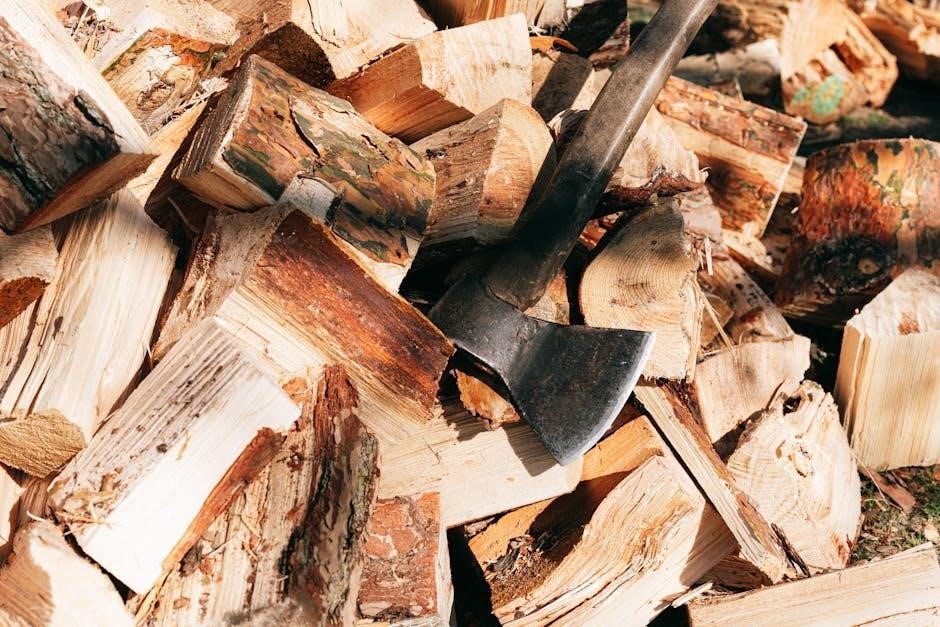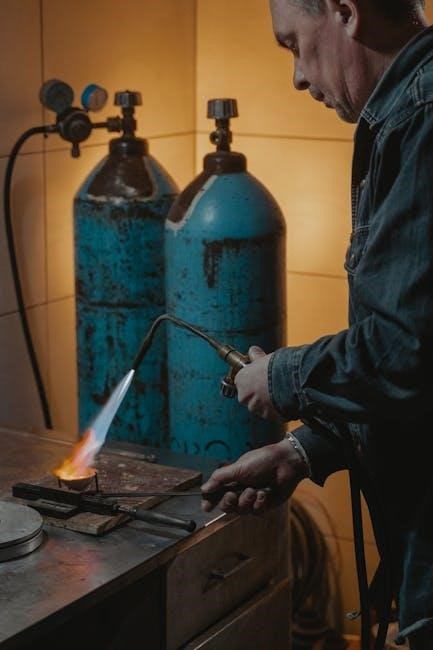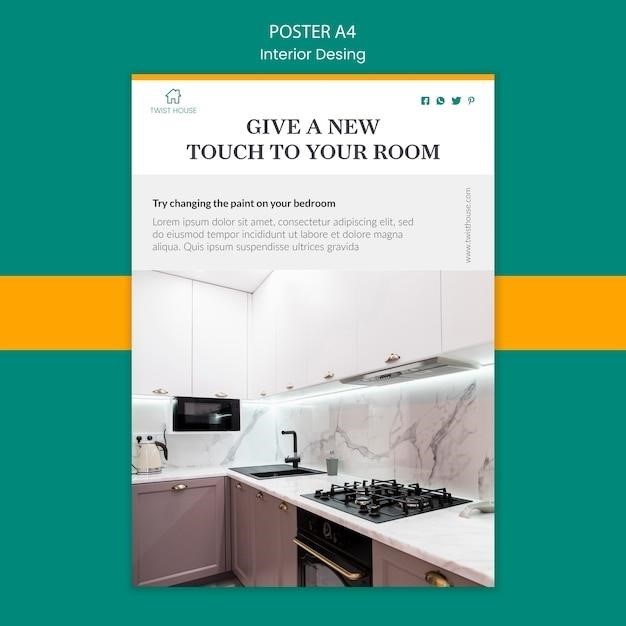The Allen + Roth gas log manuals provide essential guidance for installing, maintaining, and troubleshooting gas log systems․ These manuals ensure safe operation and compliance with industry standards like ANSI and CSA certifications․ They cover key aspects such as venting requirements, ignition systems, and proper maintenance routines․ Designed for both installers and homeowners, the manuals offer detailed instructions to enhance safety and performance․ Regularly updating your knowledge with these manuals helps maintain efficiency and ambiance of your gas log fireplace․
1․1 Overview of Allen + Roth Gas Log Systems
Allen + Roth gas log systems are designed to replicate the warmth and ambiance of a traditional fireplace with modern convenience․ These systems are available in vented and vent-free configurations, offering flexibility for various installation needs․ They feature realistic log sets and advanced ignition controls, ensuring a lifelike flame experience․ Compliant with ANSI and CSA standards, Allen + Roth systems prioritize safety and energy efficiency․ With customizable options and eco-friendly designs, they cater to diverse home decor styles while providing reliable performance for years of enjoyment․
1․2 Importance of Following the Manual
Following the Allen + Roth gas log manual is crucial for ensuring safe and efficient operation of your gas log system․ The manual provides detailed instructions for installation, maintenance, and troubleshooting, helping users avoid potential hazards․ It outlines compliance with industry standards like ANSI and CSA, ensuring your system meets safety regulations․ Proper adherence to the manual prevents gas leaks, ignition issues, and other risks․ Additionally, it serves as a reference for diagnosing common problems and scheduling professional servicing when needed, ultimately extending the lifespan of your gas log system and maintaining its performance․

Installation Guidelines
Allen + Roth gas log installation requires compliance with ANSI and CSA standards, proper venting, and adherence to clearance specifications for safe and efficient system operation․
2․1 Pre-Installation Requirements
Before installing Allen + Roth gas logs, ensure compliance with ANSI Z21․60-2017 and CSA 2․26-2017 standards for decorative gas appliances․ Verify local building codes and regulations․ Inspect the gas line for leaks and ensure proper connections․ Check venting systems for clearance and damage, adhering to specified venting requirements․ Ensure the fireplace area is clear of flammable materials․ A qualified technician must handle the installation to guarantee safety and efficiency, as improper setup can lead to hazards․ Proper preparation ensures a safe and functional gas log system․ Always follow manufacturer instructions for optimal results․
2․2 Step-by-Step Installation Process
Begin by reviewing the Allen + Roth gas log manual for specific instructions․ Turn off the gas supply and ensure the area is clear․ Carefully unpack and inspect all components for damage․ Install the burner assembly according to the manufacturer’s guidelines, ensuring proper alignment․ Place the logs in the recommended configuration for realistic appearance․ Connect the gas line securely, double-checking for leaks․ Install the venting system, adhering to clearance and safety standards․ Turn on the gas supply slowly and test the ignition system․ Follow the manual’s troubleshooting section if issues arise․ Ensure all connections comply with ANSI and CSA standards for safe operation․
2․3 Venting and Clearance Specifications
Proper venting and clearance are critical for safe and efficient operation of Allen + Roth gas log systems․ Ensure venting systems comply with ANSI Z21․60 and CSA 2․26 standards․ Vented systems require a chimney or vent pipe, while vent-free systems must meet specific room size and ventilation requirements․ Maintain minimum clearances to combustible materials, typically 12-18 inches, depending on the model․ Always follow the manual’s venting configurations to prevent carbon monoxide hazards․ Proper installation ensures safe operation and optimal performance of your gas log system․

Maintenance and Upkeep
Regular maintenance ensures optimal performance and safety․ Clean gas logs gently with a soft brush and inspect for wear․ Replace damaged parts promptly and follow seasonal care tips for longevity․
3․1 Cleaning the Gas Logs
Cleaning Allen + Roth gas logs is essential for maintaining their realistic appearance and functionality․ Use a soft-bristle brush to gently remove dust and soot buildup․ Avoid harsh chemicals or abrasive materials that could damage the logs․ For more thorough cleaning, turn off the gas supply and allow the logs to cool completely․ Use a mild soap solution and a soft cloth to wipe down the logs, ensuring they remain undamaged․ Regular cleaning prevents debris accumulation and ensures proper gas flow and ignition efficiency․ Always refer to the manual for specific cleaning recommendations tailored to your model․
3․2Inspecting and Replacing Worn Parts
3․2 Inspecting and Replacing Worn Parts
Regular inspection of Allen + Roth gas log systems is crucial for ensuring optimal performance and safety․ Check for wear on key components like burners, ignition electrodes, and logs․ Look for signs of deterioration, such as cracks, rust, or soot buildup․ Refer to the manual for specific inspection guidelines․ If any part is damaged, replace it immediately with genuine Allen + Roth parts to maintain compliance with ANSI and CSA standards․ Proper replacement ensures reliable operation and prevents potential hazards․ Always turn off the gas supply before performing inspections or replacements․
3․3 Seasonal Maintenance Tips
Seasonal maintenance is vital to keep your Allen + Roth gas log system functioning efficiently․ Before the heating season, clean the venting system and ensure all connections are secure․ Inspect the logs and burner for soot buildup and clean as needed․ Check the gas line for leaks and ensure proper ventilation․ Store any unused parts in a dry place to prevent damage․ Refer to the manual for specific seasonal care instructions to maintain performance and safety․ Regular maintenance ensures your gas log system remains reliable and enhances your home’s ambiance year-round․

Safety Precautions
Adhere to ANSI and CSA standards, ensure proper ventilation, and handle gas leaks promptly․ Regular inspections and following manual guidelines are crucial for safe operation and emergency preparedness․
4․1 Understanding Safety Certifications

Allen + Roth gas log systems comply with ANSI Z21․60-2017 and CSA 2․26-2017 standards, ensuring safety and performance․ These certifications verify that the products meet rigorous requirements for gas appliances, focusing on combustion safety, venting, and operational reliability․ Understanding these certifications helps users trust the product’s quality and safety․ Proper installation and regular inspections further ensure compliance, preventing potential hazards․ Always look for these certifications when installing or maintaining your gas log system to guarantee safe and efficient operation․
4․2 Handling Gas Leaks and Emergencies
In case of a gas leak or emergency, immediately turn off the gas supply and open windows for ventilation․ Never use electrical devices or ignite flames nearby․ Evacuate the area and contact a qualified technician or emergency services․ Follow the Allen + Roth manual’s specific instructions for shutting down the system․ Do not attempt to restart the appliance until it has been professionally inspected and cleared for safe use․ Prompt action is crucial to prevent potential hazards and ensure safety․ Always prioritize caution when dealing with gas-related issues․
4․3 Proper Ventilation Practices
Proper ventilation is critical for safe and efficient operation of Allen + Roth gas log systems․ Ensure your fireplace is installed with the correct venting components as specified in the manual․ Vent pipes must be unobstructed and meet clearance requirements to prevent gas buildup․ Regularly inspect vents for blockages or damage․ Improper ventilation can lead to carbon monoxide risks․ Always follow local building codes and manufacturer guidelines․ Proper airflow ensures both safety and optimal performance of your gas log system, enhancing your home’s ambiance without compromising air quality or safety standards․

Troubleshooting Common Issues
Allen + Roth gas log manuals guide users through resolving common issues like pilot light malfunctions, gas flow restrictions, and ignition system failures․ Refer to the troubleshooting section for step-by-step solutions and ensure proper functionality of your gas log system with ease․
5․1 Pilot Light Issues
Pilot light issues, such as staying on or flickering, can indicate problems with your Allen + Roth gas log system․ Check for dirt or debris in the pilot orifice, as this often disrupts proper function․ Ensure the gas supply is stable and verify that the pilot light is adjusted correctly․ If the pilot light refuses to stay lit, inspect the thermocouple for damage or misalignment․ Refer to your manual for detailed troubleshooting steps and safety precautions to resolve these issues effectively and maintain optimal performance of your gas log system․
5․2 Gas Flow Problems
Gas flow issues in Allen + Roth gas log systems can disrupt operation, often due to blockages or incorrect regulator settings․ Check the gas line for kinks or obstructions and ensure the shut-off valve is fully open․ Verify that the regulator is properly adjusted as per the manual․ If issues persist, inspect the venting system for restrictions, as improper ventilation can affect gas flow․ Always turn off the gas supply before troubleshooting and consult a professional if adjustments are beyond your expertise to ensure safe and efficient operation of your gas log system․
5․3 Ignition System Malfunctions
Ignition system malfunctions in Allen + Roth gas logs can prevent the system from lighting properly․ Common issues include the pilot light not staying lit or intermittent clicking sounds without ignition․ Check the pilot orifice for dirt or blockages and ensure the regulator is set correctly․ If the igniter doesn’t spark, inspect the electrode for wear or corrosion․ Always turn off the gas supply before attempting repairs․ For persistent issues, consult the manual or contact a certified technician to ensure safe and reliable operation of your gas log system․

Technical Specifications
Allen + Roth gas logs comply with ANSI Z21․60-2017 and CSA 2․26-2017 standards, offering efficient BTU ratings and compatibility with natural or propane gas for optimal performance․
6․1 Compliance with ANSI and CSA Standards
Allen + Roth gas log systems are designed to meet rigorous ANSI Z21․60-2017 and CSA 2․26-2017 standards․ These certifications ensure the products are safe, reliable, and energy-efficient․ Compliance involves passing extensive testing for emissions, venting systems, and overall performance․ Adhering to these standards guarantees that Allen + Roth gas logs provide a secure and environmentally friendly option for homeowners․ The certifications also ensure compatibility with various installation requirements, making the systems versatile for different home setups․
6․2 BTU Ratings and Fuel Efficiency
Allen + Roth gas log systems feature varying BTU ratings to suit different heating needs․ These ratings indicate the unit’s energy output, ensuring optimal performance․ Higher BTU models are ideal for larger spaces, while lower BTU options are perfect for smaller areas․ The systems are designed for fuel efficiency, minimizing gas consumption while maintaining warmth․ The manuals provide detailed BTU specifications and tips for maximizing efficiency․ By understanding BTU ratings, users can choose the right model and enjoy consistent, energy-saving performance․ Proper sizing and setup are crucial for achieving the best fuel efficiency and overall satisfaction․
6;3 Compatibility with Various Gas Types
Allen + Roth gas log systems are designed to work with various gas types, including natural gas and propane․ The manuals specify the compatibility of each model, ensuring proper installation and operation․ Conversion kits are often provided for switching between gas types, and the manuals outline the necessary steps․ Compliance with ANSI and CSA standards guarantees safe performance across different fuel options․ Understanding gas type compatibility is crucial for optimal functionality and efficiency․ Always refer to the manual to confirm compatibility before installation or conversion to ensure safety and performance․

User Responsibilities
Users must adhere to safety guidelines, perform regular inspections, and store manuals properly․ They should follow manufacturer instructions and schedule professional servicing as recommended to ensure optimal performance․
7․1 Regular Inspection Requirements
Regular inspections are crucial for maintaining the safety and efficiency of your Allen + Roth gas log system․ Users should inspect the venting system, gas lines, and log sets for damage or blockages․ Ensure the pilot light functions correctly and check for any signs of wear on ignition components․ Inspections should be conducted monthly during active use and annually by a certified professional․ Properly documenting findings helps track maintenance and ensures compliance with safety standards․ Regular checks prevent potential hazards and maintain optimal performance, providing peace of mind and extending the system’s lifespan․
7․2 Storing the Manual Properly
Proper storage of the Allen + Roth gas log manual ensures it remains accessible and undamaged for future reference․ Keep it in a dry, secure location away from direct sunlight and moisture․ Avoid folding or creasing pages to maintain readability․ Consider storing it in a protective cover or binder to prevent wear․ For added convenience, digital copies can be saved to your device or cloud storage․ Regularly check the manual’s condition and replace it if damaged․ Proper storage ensures critical information remains available for troubleshooting, maintenance, and installation guidance when needed․
7․3 Scheduling Professional Servicing
Scheduling professional servicing for your Allen + Roth gas log system is crucial for maintaining safety, efficiency, and longevity․ Annual inspections by certified technicians ensure compliance with ANSI and CSA standards, while addressing potential issues before they escalate․ Technicians will inspect venting systems, gas lines, and ignition components, ensuring optimal performance․ Regular servicing also helps prevent gas leaks and carbon monoxide risks․ Keep a record of all maintenance visits, as this may be required for warranty validation․ By prioritizing professional servicing, you protect your investment and ensure a safe, enjoyable fireplace experience year-round․

Environmental Considerations
Allen + Roth gas log systems are designed with eco-friendly features to minimize environmental impact, promoting energy efficiency and sustainable home heating solutions while maintaining safety standards․
8․1 Eco-Friendly Features of Allen + Roth Gas Logs
Allen + Roth gas logs incorporate eco-friendly features such as energy-efficient combustion systems, reducing fuel consumption and lowering emissions․ These systems are designed to minimize environmental impact while providing optimal heating performance․ By utilizing advanced technologies, they ensure a cleaner burn, producing fewer pollutants compared to traditional wood-burning fireplaces․ Additionally, their design promotes sustainable energy use, aligning with modern environmental standards and contributing to a greener home heating solution․ These innovations make Allen + Roth gas logs a responsible choice for environmentally conscious homeowners seeking to reduce their carbon footprint without compromising on comfort or aesthetics․
8․2 Reducing Carbon Footprint
Allen + Roth gas logs are designed to minimize environmental impact by reducing carbon emissions․ Their energy-efficient combustion systems ensure optimal fuel usage, lowering greenhouse gas output․ Compared to traditional wood-burning fireplaces, these gas logs produce fewer pollutants, contributing to a cleaner environment․ By using natural gas, a cleaner-burning fuel, they significantly reduce emissions of harmful air pollutants․ Regular maintenance and proper usage, as outlined in the manual, further enhance their eco-friendly performance․ This makes Allen + Roth gas logs a sustainable choice for homeowners seeking to reduce their carbon footprint while enjoying the ambiance of a fireplace․
8․3 Proper Disposal of Old Parts
Proper disposal of old Allen + Roth gas log parts is essential for environmental sustainability․ Always check local regulations for specific guidelines on disposing of metal, ceramic, and other materials․ Many components can be recycled, reducing landfill waste․ Hazardous materials, if present, should be handled by certified professionals․ Ensure all gas-related parts are safely discharged before disposal․ Consulting with authorized service providers guarantees compliance with environmental standards․ Proper disposal supports eco-friendly practices and aligns with Allen + Roth’s commitment to sustainability․

Design and Aesthetics
Allen + Roth gas logs feature realistic designs, mimicking natural wood textures and flame patterns․ Customizable options enhance ambiance, offering a cozy focal point for any room․
9․1 Realistic Log Set Designs
Allen + Roth gas log sets are crafted with meticulous attention to detail, offering realistic wood textures and natural flame patterns․ The logs are designed to mimic the appearance of real wood, complete with intricate bark details and varying sizes for authenticity․ These designs enhance the visual appeal of your fireplace, creating a cozy and inviting ambiance․ With customizable options, homeowners can choose log sets that complement their interior decor․ The manuals provide guidance on arranging the logs for the most realistic effect, ensuring a seamless blend of functionality and aesthetics in your home․
9․2 Customization Options
Allen + Roth gas log systems offer versatile customization options to suit various home decors․ Homeowners can choose from different log styles, finishes, and burner configurations to create a personalized look․ The manuals guide users on selecting compatible decorative accessories, such as glowing embers or lava rock, to enhance the visual appeal․ Additionally, adjustable flame height and ignition controls allow for tailored comfort and ambiance․ These customization features ensure that your gas log system blends seamlessly with your interior design while maintaining functionality and safety standards․ This flexibility makes Allen + Roth systems a popular choice for homeowners seeking unique solutions․
9․3 Enhancing Home Ambiance
Allen + Roth gas log systems are designed to enhance home ambiance by creating a cozy and inviting atmosphere․ The realistic flame patterns and glowing embers mimic the warmth of a traditional fireplace․ With options for adjustable flame height and remote control, users can easily customize the ambiance to suit any occasion․ The manual provides tips on optimizing the visual appeal of the gas logs by properly arranging the log set and using decorative accessories․ This ensures a harmonious blend of functionality and aesthetics, making your fireplace the focal point of your living space while maintaining comfort and safety․



